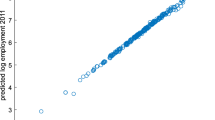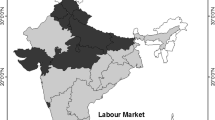Abstract
This study conducts a spatio-temporal analysis of labor flexibilization and GDP per capita change (gross domestic product) with focus on their interrelation in European Union (EU) regions during 2008–2013. Using a composite index to calculate the dispersion of flexible contractual arrangements and spatio-temporal autocorrelation metrics, it shows that changes in overall growth largely affect the distribution of flexible working patterns across space and time. In particular, regions with high increments in the prevalence of flexible work, thus ranking highest in terms of flexibilization, suffered the most as a result of the productivity and financial crisis during the turbulent 2008–2013 period. Further, applying univariate, bivariate, and differential local Moran’s I spatial autocorrelation techniques, this study demonstrates that changes in GDP pca are negatively spatially autocorrelated with flexibilization, while increasing flexibility has no significant positive effect on GDP growth. This major finding contradicts the general belief that more flexible labor environments lead a priori to economic growth, re-emphasizing previous considerations on that matter while also updating existing contributions with a more nuanced and recent account that follows a geographically sensitive methodology. Although many studies have identified that labor flexibilization is not always linked to economic growth, the current study offers recent spatio-temporal evidence that refer to almost all EU regions to complement existing works. Contextualizing these findings, this analysis highlights an increasing schism between the north-central and south-eastern EU regions, with the latter facing poor growth prospects and extensive low-road flexibilization practices. Such a schism, which often transcends national boundaries creating new patterns of sub-national unevenness, challenges the idea of a healthy trade-off between flexibilization and GDP growth and warrants urgent attention.




Similar content being viewed by others
Notes
Correlations among indicators used were estimated through the Pearson product-moment coefficient in the initial attempt to establish an FCA CI (Gialis and Taylor 2016) and have been re-verified for the new calculation at hand. The qualitative assessment between ‘very weak’ (i.e., 0.0 < |R| < 0.2) and ‘very strong’ (0.8 < R < 1.0) of the inter-indicator correlation is defined by diving the range of possible values linearly into five equal intervals. The inter-correlation matrix revealed that FCA2_1 and FCA2_3 very strongly anti-correlate across all study years (2005, 2008 and 2013). Nine other sub-index pairs appear to correlate ‘strongly’ (i.e., 0.6 < R < 0.8), including FCA1_2 and FCA1_4. In order to remove or not an indicator that was highly correlated with another, it was necessary to estimate whether both indicators can represent the same phenomenon. For permanent employment (FCA1_4), it was found that a strong negative correlation existed with self-employment (FCA1_2), in turn, related to that high shares of permanent employees are always related to leads minor shares of self-employment. Yet, both indicators were retained as they represent different labor market categories. Also, self-employment captures new trends in flexibility, such as subcontracting or gig-economy work and should be retained. For the redundancy check we applied principal components analysis on the indicators used for the FCA index. It came out that seven of the eight indicators in the correlation matrix have a single strong or very strong component loading, and thus they are accounted for to a large extent by a single principal component As such, there is no opportunity for reducing the dimensionality of the CI and the complete list of indicators has been retained.
The administrative boundaries for EU countries are modeled as polygons at the NUTS-2 level and use the geographic coordinate reference system, European Terrestrial Reference System 1989 (ETRS89), for the reference year 2013 at the 1:60 M scale (GISCO 2015). Spatial data were projected to the WGS84 projected coordinate system because spatial statistics require projected data to accurately measure distances.
The following countries are excluded: Czech Republic, Croatia, Cyprus, Denmark, Estonia, Ireland, Latvia, Lithuania, Luxembourg, Malta, Slovakia, and Slovenia.
References
Anselin, L. (1994). Local indicators of spatial association-LISA. Geographical Analysis, 27, 93–115.
Anselin, L. (2005). Exploring spatial data with GeoDA: A work book. Urbana-Champaign: Center for Spatially Integrated Social Science. http://www.csiss.org/clearinghouse/GeoDa/geodaworkbook.pdf. Accessed September 4, 2017.
Anselin, L. (2017). A local indicator of multivariate spatial association: Extending Geary’s c*. Center for Spatial Data Science, University of Chicago. https://s3.amazonaws.com/geoda/docs/LA_multivariateGeary1.pdf. Accessed September 4, 2017.
Bailey, N., Holly, S., & Pesaran, M. H. (2016). A two-stage approach to spatio-temporal analysis with strong and weak cross-sectional dependence. Journal of Applied Econometrics, 31(1), 249–280.
Barbieri, P., & Cutuli, G. (2015). Employment protection legislation, labour market dualism, and inequality in Europe. European Sociological Review, 32(4), 501–516.
Benjamini, Y. (2010). Discovering the false discovery rate. Journal of the Royal Statistical Society: Series B, 72(4), 405–416. https://doi.org/10.1111/j.1467-9868.2010.00746.x.
Benjamini, Y., & Hochberg, Y. (1995). Controlling the false discovery rate: A practical and powerful approach to multiple testing. Journal of the Royal Statistical Society: Series B, 57(1), 289–300.
Boeri, T. (2010). Institutional reforms and dualism in European labor markets. In O. Ashenfelter & D. Card (Eds.), Handbook of labor economics (pp. 1173–1236). Amsterdam: Elsevier.
Castro, M., & Singer, B. (2006). Controlling the false discovery rate: A new application to account for multiple and dependent test in local statistics of spatial association. Geographical Analysis, 38, 180–208.
Dall’erba, S. (2009). Methods: Exploratory spatial data analysis. In R. Kitchin & N. Thrift (Eds.), International encyclopedia of human geography (Vol. 3, pp. 683–690). Oxford: Elsevier.
Doran, J., & Fingleton, B. (2016). Employment resilience in Europe and the 2008 economic crisis: Insights from micro-level data. Regional Studies, 50(4), 644–656.
Esty, D. C., Levy, M., Srebotnjak, T., & de Sherbinin, A. (2005). Environmental sustainability index: benchmarking national environmental stewardship. New Haven: Yale Center for Environmental Law & Policy.
European Commission. (2015a). Council Decision (EU) 2015/1848 of 5 October 2015 on guidelines for the employment policies of the Member States for 2015. http://eur-lex.europa.eu/legal-content/EN/ALL/?uri=OJ:JOL_2015_268_R_0005. Accessed September 4, 2017.
European Commission. (2015b). Council Recommendation (EU) 2015/1184 of 14 July 2015 on broad guidelines for the economic policies of the Member States and of the European Union. http://eur-lex.europa.eu/legal-content/EN/TXT/?uri=OJ%3AJOL_2015_192_R_0009. Accessed September 4, 2017.
European Commission. (2016). European semester: Thematic factsheet—Employment protection legislation. https://ec.europa.eu/info/strategy/european-semester/thematic-factsheets/labour-markets-and-skills_en. Accessed September 4, 2017.
Eurostat. (2015). Regions in the European Union—Nomenclature of territorial units for statistics—NUTS 2013/EU-28. http://ec.europa.eu/eurostat/documents/3859598/6948381/KS-GQ-14-006-EN-N.pdf/b9ba3339-b121-4775-9991-d88e807628e3. Accessed September 4, 2017.
Eurostat. (2016). Regional economic accounts—ESA 2010 (reg_eco10). Metadata report and detailed tables. http://ec.europa.eu/eurostat/cache/metadata/en/reg_eco10_esms.htm#data_rev1488893216624; http://ec.europa.eu/eurostat/data/database?node_code=nama_10r_2gdp, Table GDP pca: [nama_10r_2gdp]. Accessed September 4, 2017.
Gebel, M., & Giesecke, J. (2011). Labor market flexibility and inequality: The changing skill-based temporary employment and unemployment risks in Europe. Social Forces, 90(1), 17–39.
Gebel, M., & Giesecke, J. (2016). Does deregulation help? The impact of employment protection reforms on youths’ unemployment and temporary employment risks in Europe. European Sociological Review, 32(4), 486–500.
Getis, A., & Ord, J. K. (1992). The analysis of spatial association by distance statistics. Geographical Analysis, 24, 189–206.
Gialis, S., Gourzis, K., & Underthun, A. (2017). Going under-employed: Industrial and regional effects, specialization and part-time work across recession-hit Southern European Union regions. European Urban and Regional Studies. https://doi.org/10.1177/0969776417713054.
Gialis, S., & Leontidou, L. (2016). Antinomies of flexibilization and atypical employment in Mediterranean Europe: Greek, Italian and Spanish regions during the crisis. European Urban and Regional Studies, 23(4), 716–733.
Gialis, S., & Taylor, M. (2016). A regional account of flexibilization across the EU: The ‘Flexible Contractual Arrangements’ composite index and the impact of recession. Social Indicators Research, 128(3), 1121–1146.
Gilmartin, M., & Korobilis, D. (2012). On regional unemployment: An empirical examination of the determinants of geographical differentials in the UK. Scottish Journal of Political Economy, 59(2), 179–195.
GISCO. (2015). Geographical Information and maps. http://ec.europa.eu/eurostat/web/gisco/geodata/reference-data/administrative-units-statistical-units/nuts#nuts13. Accessed June 12, 2017.
Goovaerts, P. (2010). How do multiple testing correlation and spatial autocorrelation affect areal boundary analysis. Spatial and Spatio-temporal Epidemiology, 1(4), 219–229.
Grekousis, G. (2018). Further widening or bridging the gap? A cross-regional study of unemployment across the EU amid crisis. Sustainability, 10(6), 1702. https://doi.org/10.3390/su10061702.
Grekousis, G., & Mountrakis, G. (2015). Sustainable development under population pressure: Lessons from developed land consumption in the conterminous U.S. PLoS ONE, 10(3), e0119675. https://doi.org/10.1371/journal.pone.0119675.
Grekousis, G., Mountrakis, G., & Kavouras, M. (2016). Linking MODIS-derived forest and cropland land cover 2011 estimations to socioeconomic and environmental indicators for the European Union’s 28 countries. GIScience & Remote Sensing, 53(1), 122–146. https://doi.org/10.1080/15481603.2015.1118977.
Harvey, D. (2010). The Enigma of capital: And the crises of capitalism. Oxford: Oxford University Press.
Kalleberg, A. L., & Marsden, P. V. (2015). Transformation of the employment relationship. In J. A. Tainter, T. G. Taylor, R. G. Brain, & J. Lobo (Eds.), Emerging trends in the social and behavioral sciences: An interdisciplinary, searchable, and linkable resource (pp. 1–15). New York: Wiley.
Keune, M., & Jepsen, M. (2007). Not balanced and hardly new: the European Commission's quest for flexicurity. European Trade Union Institute WP 2007/01. http://library.fes.de/pdf-files/gurn/00281.pdf.
Lloyd, C. D. (2010). Local models for spatial analysis (2nd ed.). Boca Raton, FL: CRC Press.
Marelli, E., Patuelli, R., & Signorelli, M. (2012). Regional unemployment in the EU before and after the global crisis. Post-communist Economies, 24(2), 155–175.
Markusen, A. (1996). Sticky places in slippery space: a typology of industrial districts. Economic Geography, 72(3), 293–313.
Massey, D. (1996). Spatial divisions of labour: social structures and the geography of production. London: Macmillan.
McGrath, S., Herod, A., & Rainnie, A. (2010). Handbook of employment and society: Working space. Massachusetts: E. Elgar.
Netrdová, P., & Nosek, V. (2016). Spatial patterns of unemployment in Central Europe: Emerging development axes beyond the Blue Banana. Journal of Maps, 12(4), 701–706.
Noelke, C. (2015). Employment protection legislation and the youth labour market. European Sociological Review, 32, 471–485.
Osborne, D. B., & Difei, H. (2010). Technical note on re-calculating the HDI, United Nations Development Programme, Human Development Report Office. http://hdr.undp.org/sites/default/files/hdr_2013_en_technotes.pdf.
OECD. (2011). Public investment in regions, in: OECD. Regions at a Glance 2011, OECD Publishing. http://www.oecd-ilibrary.org/sites/reg_glance-2011-en/03/13/index.html?contentType=/ns/StatisticalPublication,/ns/Chapter&itemId=/content/chapter/reg_glance-2011-13-en&containerItemId=/content/serial/19990057&accessItemIds=&mimeType=text/html.
OECD. (2017). OECD Employment Outlook 2017 (Summary). OECD Publishing, Paris. http://dx.doi.org/10.1787/2cbdf59d-en. Accessed July 22, 2017.
OECD Statistics Working Papers, 2005/03, OECD Publishing. http://dx.doi.org/10.1787/533411815016.
O’Sullivan, D., & Unwin, D. (2010). Geographic information analysis (2nd ed.). Hoboken: Wiley.
Psycharis, Y., Kallioras, D., & Pantazis, P. (2014). Economic crisis and regional resilience: Detecting the ‘geographical footprint’ of economic crisis in Greece. Regional Science Policy and Practice, 6(2), 121–141.
Rey, S. J. (2016). Space–time patterns of rank concordance: Local indicators of mobility association with application to spatial income inequality dynamics. Annals of the American Association of Geographers, 106, 788–803.
Saltelli, A. (2007). Composite indicators between analysis and advocacy. Social Indicators Research, 81(1), 65–77.
United Nations Development Programme. (1990). Human development report 1990-concept and measurement of human development, New York.
Viebrock, E., & Clasen, J. (2009). Flexicurity and welfare reform: a review. Socioeconomic Review, 7, 305–331.
Yamada, I., & Thill, J.-C. (2007). Local indicators of network-constrained clusters in spatial point patterns. Geographical Analysis, 39, 268–292.
Funding
This work was supported by Sun Yat Sen University Starting Research Grant for George Grekousis (37000-18821113).
Author information
Authors and Affiliations
Corresponding author
Electronic supplementary material
Below is the link to the electronic supplementary material.
Rights and permissions
About this article
Cite this article
Grekousis, G., Gialis, S. More Flexible Yet Less Developed? Spatio-Temporal Analysis of Labor Flexibilization and Gross Domestic Product in Crisis-Hit European Union Regions. Soc Indic Res 143, 505–524 (2019). https://doi.org/10.1007/s11205-018-1994-0
Accepted:
Published:
Issue Date:
DOI: https://doi.org/10.1007/s11205-018-1994-0




